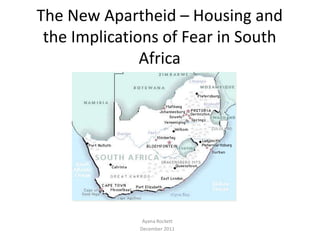
The New Apartheid – Housing And The Implications
- 1. The New Apartheid – Housing and the Implications of Fear in South Africa Ayana Rockett December 2011
- 2. Fear perpetuates social divisions that were inherent in Apartheid. The fear of crime being used as a justification for a predominantly racist fear of difference
- 3. Apartheid “Apartness” • Apartheid was a system of racial segregation enforced by the National Party governments of South Africa between 1948 and 1994. • Non white south Africans were curtailed and Afrikaner minority rule was maintained. • Non white political representation was abolished in 1970 and black people were robbed of their citizenship and legally became citizens of tribally based, self governing “bantustans” • Pillars of Grand Apartheid: - Population Registration Act (1950) - Reservation of Separate Amenities Act (1953) - Black Homeland Citizenship Act (1970) **
- 5. Bantustans
- 6. “Architecture of Fear” • The fall of Apartheid began in 1990 after a series of negotiations by government and nationalist groups. • The end of Apartheid, democratization and majority rule were optimistically anticipated to bring and end to violence. • Urban panic focusing on criminal activity **
- 7. “Architecture of Fear” Fear has always influenced Urban Planning • Baron Haussman – boulevards fragmenting revolutionary threat of underclass • Le Corbusier – eliminated streets, replacing them with artificially “pure” environments • Oscar Newman/Jane Jacobs – defensible space, natural surveillance
- 8. “Architecture of Fear” State led efforts to mitigate fear have been usurped by private, individual citizen responses
- 9. Cape Town Ruthless spacial polarization Third largest city Most common are violent personal crimes, property crimes Khayelitsha – fastest growing shantytown in South Africa **
- 10. Crime Threat of victimization affects behavior • Crime is not uniform. Socio-spacial legacy of apartheid concentrates crime in black areas. • 80% of white victimizations occurs outside of neighborhood boundaries • Aggravated by skewed distribution of personal and institutional resources Fear Media increases anxiety
- 11. Citizen Responses to Crime Fortification is common among the poor and the rich • Black: dogs, window grills, high fences. • Coloureds: burgular alarms • Wealthy: Excessive - blocked themselves - high walls - closed streets - security guards - electric fences - CCTV
- 15. Consequences of Fortification - Rejects efforts to address socio-spacial issues activity corridors - Increases crime - Decreases public responsibility for public space - Promotes inequality, fear and segregation - Limits social mixing, increasing distrust between groups - Prevents “freedom of movement” - Promotes “fear of crime” rhetoric - Encourages poverty by exclusion and concentrating the poor small spaces with limited resources and political leverage
- 16. Discussion Whites have long used the “fear of crime” as a euphemism for a fear of blacks. • Whites blame crime on the new black governments inability to rule. Black see it as unfinished democracy. • More “acceptable” discourses revolve around decreased property value, environmental degradation and increased taxes all conceal a racist fear of the “other”. • The concept of “fear” creates conditions that mirror the Apartheid city in that it justifies exclusion, uses spacial mechanisms to displace social problems, and dominance of social and symbolic exclusionism.
- 17. Solution • Government planning needs to encourage diversity • It needs to address citizen needs • It needs to enforce the negative public consequences of unchecked public action. • Combat the symbols of exclusionism